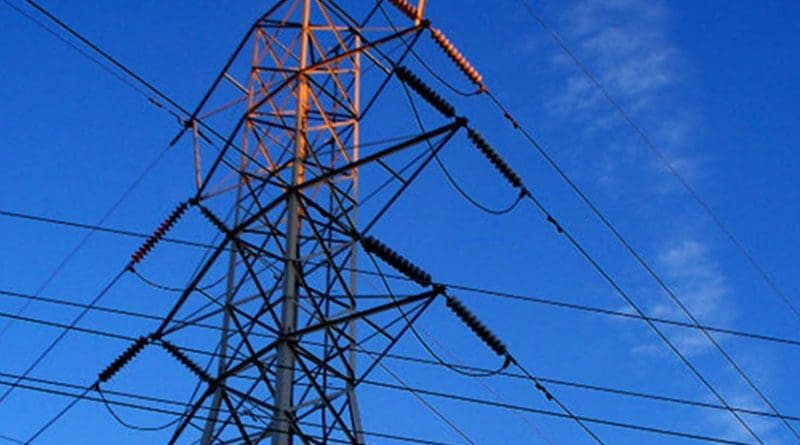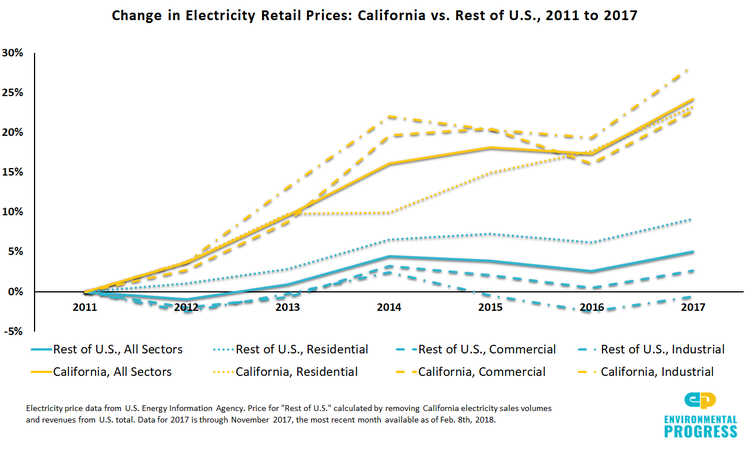California Electricity Prices Rose Three Times More In 2017 Than Rest Of US – OpEd
Between 2016 and 2017, California’s electricity prices rose three times more than they did in the rest of the United States, according to a new analysis by Environmental Progress.
The increases came despite 2017 having had the highest output of hydroelectricity — the state’s cheapest source of electricity — since 2011. Electricity prices in the rest of the United States outside California rose two percent, the same as the rate of inflation.
Between 2011 and 2017, California’s electricity prices rose five times faster than they did nationally. Today, Californians pay 60 percent more, on average, than the rest of the nation, for residential, commercial and industrial electricity.
California’s high penetration of intermittent renewables such as solar and wind are likely a key factor in higher prices. Economists agree that “the dominant policy driver in the electricity sector [in California] has unquestionably been a focus on developing renewable sources of electricity generation.”
High levels of renewable energy penetration make electricity expensive around the world, not just in California. As Germany deployed high levels of renewables over the last 10 years it saw its electricity prices rise 34 percent. Today, German electricity costs twice as much as that in neighboring France.
California’s RPS increases electricity costs in part by requiring the purchase of renewables even when they cannot be relied on to power the grid, requiring undiminished capacity from the combination of natural gas, hydro, and nuclear power. As a result, California today has a large amount of excess electricity generating capacity without being able to know if much of it will be available from day to day and week to week.
The rising cost of electricity in places with increasing penetration of intermittent renewables was predicted by German economist Lion Hirth. He found that the economic value of wind and solar must decline significantly as they become a larger part of the electricity supply. For example, the value of wind on the European grid drops 40 percent once it becomes 30 percent of electricity, Hirth finds, and the value of solar drops by half when it gets to just 15 percent. 
As wind and solar capacity climbs, the returns of usable power diminish because of increasing curtailment during surges that the grid cannot absorb. More and more intermittent capacity has to be pushed onto the grid to get less and less additional renewable electricity. The dynamic of soaring overcapacity and falling prices is the inevitable result of the fundamental inability of intermittent wind and solar generators to efficiently match supply to demand.
The burden of higher cost electricity and benefits of renewable energy subsidies fall unevenly on Californians. Between 2007 and 2014, the highest-income 40 percent of California households received three times more in solar subsidies — valued between $10,000 and $20,000 per household — as the lowest-income 40 percent. California households with over $100,000 in annual income benefitted from energy efficiency subsidies at twice the rate of households whose income was under $50,000.
Another reason for California’s high electricity prices is the closure of San Onofre Nuclear Generating Station (SONGS). “In the twelve months following the closure, natural gas generation costs increased by $350 million,” a pair of UC-Berkeley economists noted. “The closure also created binding transmission constraints, causing short-run inefficiencies and potentially making it more profitable for certain plants to act non-competitively.”
*Michael Shellenberger is president of Environmental Progress, a research and policy organization.



Perfect. It’s all part of the plan. Get us poor saps to engage in the new “green” economy and then stick it to us anyway.
Elon Musk solved a similar intermittant supply/demand conundrum in South Australia to overcome damaging power outages. He built a massive storage battery, a store of energy to get over the peaks and troughs of energy production.
California is on the bleeding edge of renewable development and usage. One consequence of fashionable but dated approaches and legacy methods is that as the renewable industry becomes more efficient you are stuck with legacy technology and working methods because the Californian utilities have made a $billions in investment.
Imagine every house having a battery capable of storing power generated from local grids. Have a look at Elon Musk’s Powerwall, a work in progress
Build Village utility companies that produce, store and distribute localy, they are called energy co-operatives.